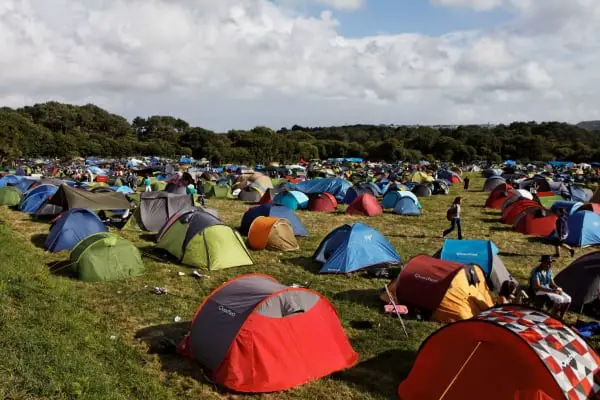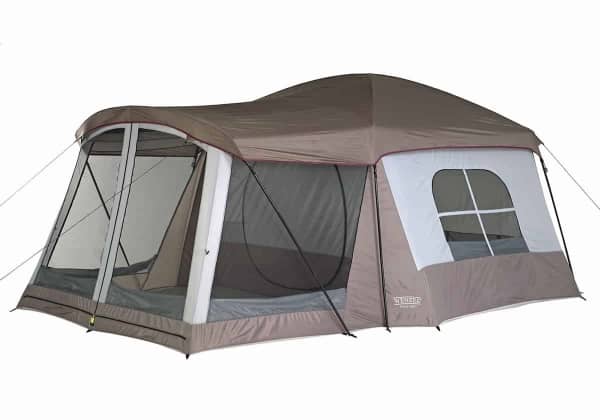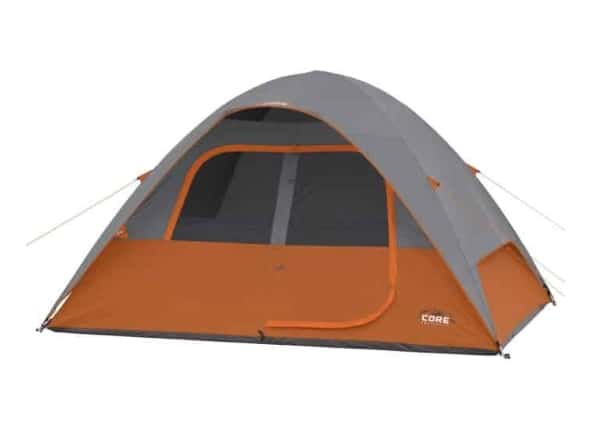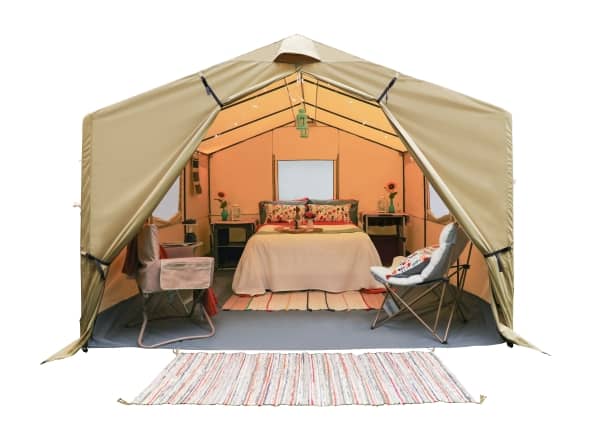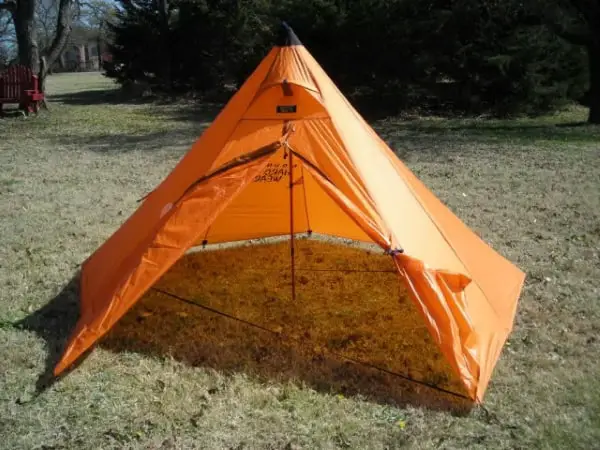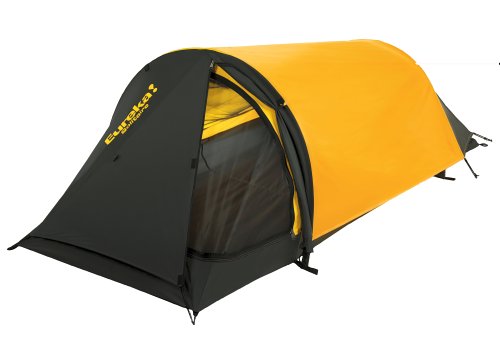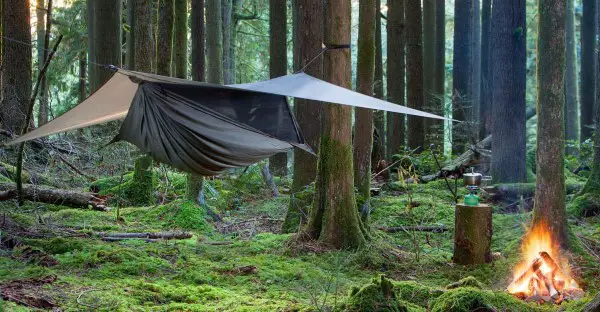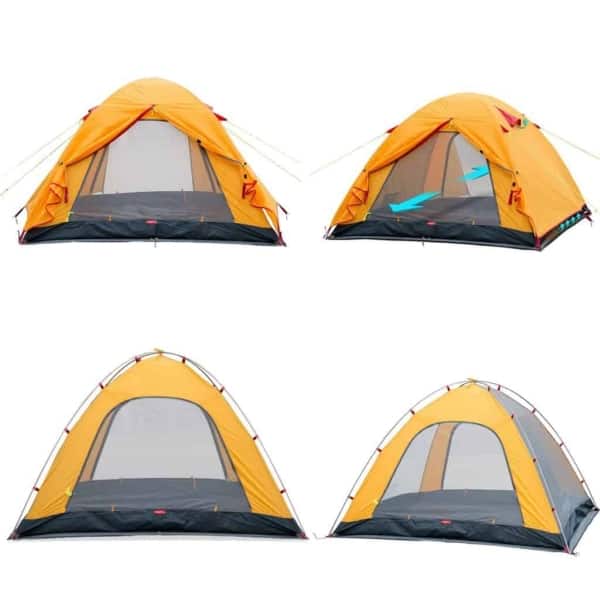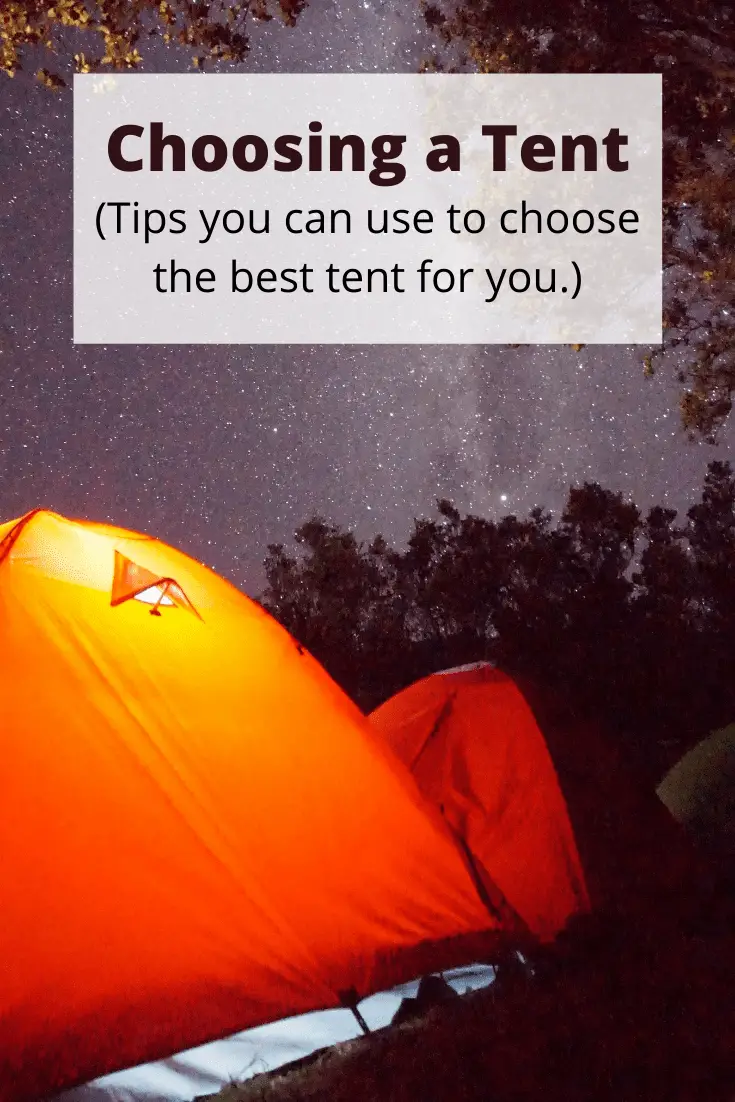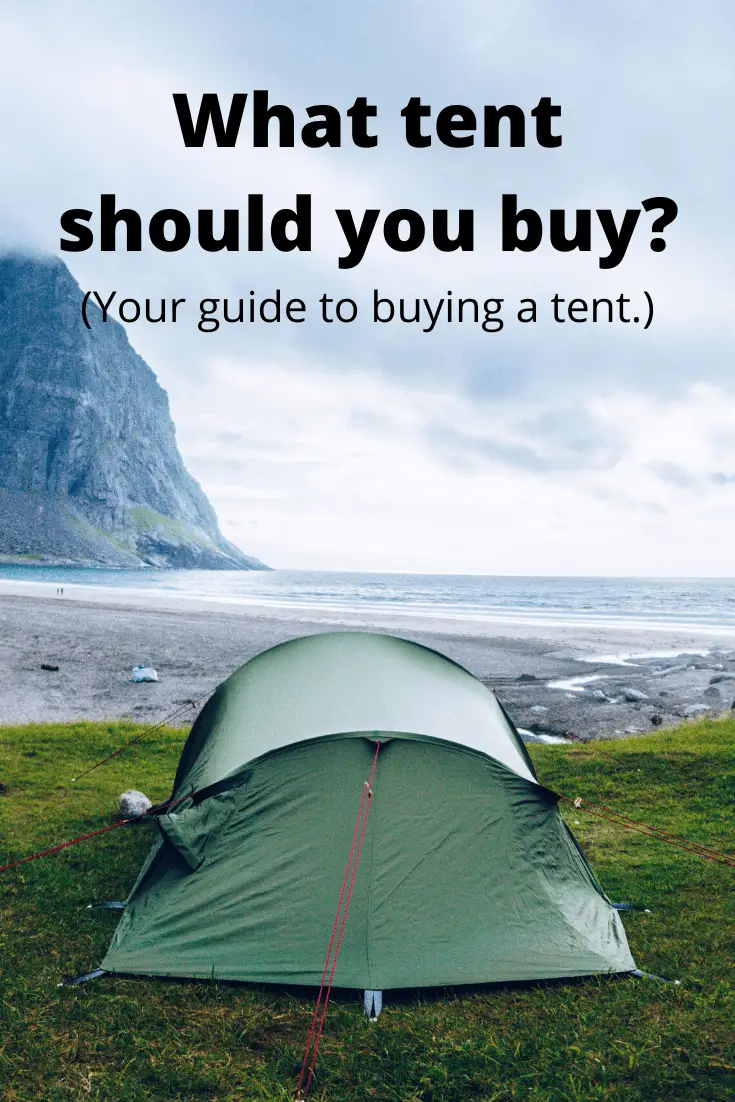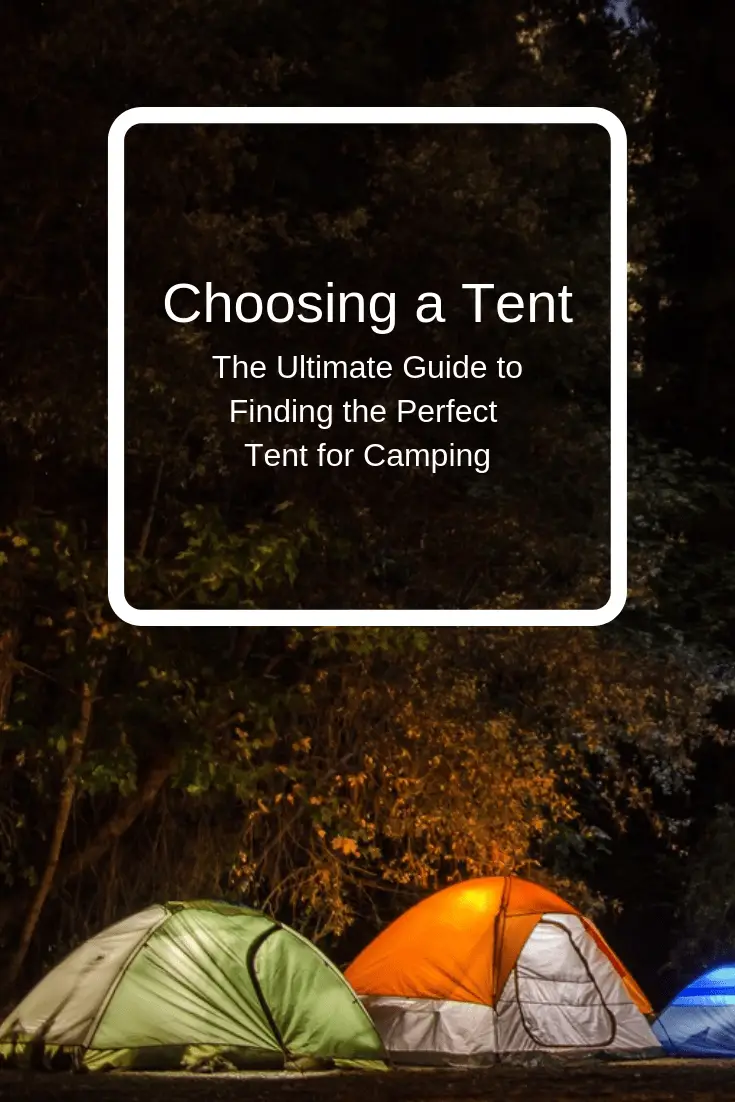Choosing a tent gets more and more complicated with each passing year. Fortunately, this is actually a good thing. The reason tents are getting more complicated is because they are getting better and more specialized.
For this reason, you’ll want to decide why you’re buying a tent in the first place.
Are you looking for a backpacking tent to take out in the summer? Do you want a tent to take car camping? How many people will be sleeping in your tent?
Once you have the answers to these questions, discovering how to buy a tent will be much easier.
In this post, I’ll break everything down so you’ll know what to look for when buying a tent.
Table of Contents
Types of Tents
There are a lot of different tent styles to choose from these days. The type you choose will largely depend on how you’ll be using the tent.
We’ll start by going over the more popular tent styles and end with some of the more unorthodox.
Cabin Tents
A cabin tent is a tent that is built with high vertical walls. This gives you more space within the tent and in many cases, you can even set up cots near the walls without worrying about sitting into them.
Advantages of Cabin Tents
- Can offer multiple rooms.
- The design maximizes space.
- Usually has more head-room.
- Offers more built-in amenities.
These tents often come with multiple rooms as well as multiple windows and can make you feel like you’re living in a small house. Sometimes they’ll have screen rooms built into the front with floors and sometimes without floors.
Often-times you’ll find cabin tents with built-in slots for extension cords, built-in storage pockets, and even places on the ceiling to hang lights and small camping fans. For this reason, many glampers prefer camping in cabin style tents.
Since these tents are built with multiple people in mind, you’ll often find them with multiple doors as well as privacy walls within the tent. This is nice for providing privacy for getting changed but obviously, it will not give you any privacy when it comes to noise.
Disadvantages of Cabin Tents
- They take up a lot of space.
- They are usually harder to set up.
- The size and weight of these tents restrict their use.
- They don’t hold up as well in high winds.
Cabin tents usually require a little more effort to set up and some of the larger ones may require the use of two people to properly set up. Also, because of their size, you’ll only be able to set them up in larger campsites.
The vertical walls are not as resistant to wind and these tents are too heavy and bulky to take on a backpacking trip. Even canoe campers might want to stay away from these tents as they’ll take up a lot of room in a canoe and they might not withstand the faster winds you’ll experience when camped next to a river or ocean.
Here is an image of a large cabin tent with a screen room on the front.
Dome Tents
A dome tent gets its name due to the fact that it is shaped like a dome. To imagine what a dome tent looks like, picture a circle that is buried halfway into the ground with just the top half sticking out.
Advantages of Dome Tents
- Can withstand wind, rain, and snow better than most tents.
- Offers additional width due to its shape.
- They offer additional headroom throughout the tent.
- They’re easy to set up.
A dome tent is built with the weather in mind. The shape of it allows wind to flow past it and rain and snow to slide off of it with ease.
Inside a dome tent, you’ll find additional headroom as well as additional room on the sides so that you can stow your gear. In many cases, the tent is erected with the use of just two intersecting poles so you won’t spend much time setting it up.
Disadvantages of Dome Tents
- They take up a little more space than other tents.
- While dome tents are easy to set up, they still require more work to set up than other small tents.
- Dome tents offer less headroom than cabin tents and wall tents.
- Fewer built-in amenities.
- Single-room design.
A dome tent takes up more space compared to how much space it provides inside. This is because the tent is slanted towards the ground on all sides so you won’t be able to stand or even sit near the walls.
Dome tents are easy to set up but they do require some effort. A popup tent, on the other hand, goes up without any thought or real effort.
You’ll also find that dome tents don’t typically come with windows and the design doesn’t lend itself to addon rooms.
Here is a picture of a dome tent.
Wall Tents
A wall tent is a tent that has sidewalls that are completely perpendicular or nearly so. These tents are usually built with a frame and they can often be found on top of wooden platforms. Permanent and semi-permanent tent sites will often make use of this type of tent.
Advantages of Wall Tents
- The vertical walls offer up a lot of space.
- You feel like you’re in a house rather than a tent.
- Many wall tents have built-in panels for tent stovepipes.
- It is easy to get items in and out of a wall tent.
- Usually has multiple windows and doors.
Wall tents are great for people looking to get the maximum amount of space out of their tent. These tents offer up a lot of headroom and you end up feeling as if you’re in a small house rather than a tent.
It is easy to move items in and out of a wall tent and you have multiple doors to do so. Also, because these tents are generally built with permanence in mind, they often come with panels that allow you to easily put a tent heater inside.
Disadvantages of Wall Tents
- Susceptible to wind, rain, and snow.
- Difficult to set up.
- Large and heavy.
Wall tents are certainly not built for all situations. These tents are heavy, bulky, and difficult to transport.
They’re also difficult to set up and you’ll probably need at least two people to set up a big wall tent. Additionally, you may have to set up your tent on a platform or at least on flat and level ground.
Here is a picture of a wall tent.
Mountain Shelters
A mountain shelter is a type of tent that does not have a floor. A mountain shelter can be used with traditional poles or can be suspended from a tree.
Also, since it doesn’t have a bottom, campers can dig out the floor and increase the depth to allow for more standing room. Sometimes people will refer to this type of tent as a tarp tent but it is a bit different than just using a tarp instead of a tent.
Advantages of Mountain Shelters
- Quick setup.
- Lightweight.
- Can dig into the ground beneath the tent.
There aren’t a lot of parts to a mountain shelter. You basically have a pole, some guy lines, and the tarp. This makes it quick to set up and lightweight to carry.
You don’t have a floor with this tent so you can dig down into the ground to help protect yourself from extreme cold and extremely hot weather. The ground ends up insulating you so you’re not as vulnerable to the outside temperatures and you’re shielded from the wind.
Disadvantages of Mountain Shelters
- Will not keep rain out.
- Insect, bugs, and animals can get in.
- Hard to set up in sand or soft ground.
Not having a floor comes with its disadvantages as well. Firstly, you won’t really be able to keep the rain out. This is fine if you’re truly mountaineering though as the only moisture you’ll be subjected to is snow and ice.
You’ll also be exposed to any bugs, insects, or animals that may want to crawl into your tent with you. Again, this isn’t a huge problem if you’re camping at the top of a snow-covered mountain.
If you do decide to use this tent for anything other than mountaineering, you may find you have trouble setting it up. Remember, the only thing keeping this tent standing up is its center pole so setting up on the beach typically isn’t an option.
Here is a picture of a mountain shelter.
Bivy Shelters
A bivy shelter is built in the shape of a large sleeping bag. It is essentially only large enough for one person to crawl into it. These tents are very minimalistic and can be good for through-hiking long trails.
This being said, you wouldn’t want to take this tent car camping as you won’t have much room inside the tent and you will most likely get much more condensation than you’d like.
Advantages of Bivy Shelters
- Small and lightweight.
- Traps warmth quickly.
- Easy to set up.
These tents are small and do not weigh much. This is why many people will use them when on long backpacking trips.
Because these tents are small, they aren’t very difficult to set up and one person can easily do it by themselves. The small footprint is also easy to heat up as a person’s body heat won’t have far to go after leaving their sleeping bag.
Disadvantages of Bivy Shelters
- Hard to get in and out of.
- Condensation can build up quickly.
- Only room for one.
To get in and out of a bivy shelter, you have to crawl. This is kind of a hassle even for the fittest of campers and it certainly isn’t something I would look forward to each morning.
Also, because the tent is so small, condensation can build up in it quickly. Leave this tent without airflow and you’ll wake up to rain falling from the top of your tent.
Even if you love this kind of tent, you’ll never be able to share it with anyone else.
One thing I like about my canoe camping tent over my bivy tent is that it is light enough to portage but large enough to comfortably fit myself and another person. When I’m by myself, I just have more room to spread out in.
Hammock Tents
A hammock tent is exactly what it sounds like. This type of tent is strung up like a hammock and doesn’t need any poles to function.
Not only is this tent lightweight, but it also keeps you off of the ground. This can be important in wet areas and areas where the ground is not suitable for pitching a more traditional tent – think heavy slopes, mud, and rocky ground.
Advantages of Hammock Tents
- Can be extremely light-weight.
- Can be very comfortable.
- Keeps you off the ground.
Hammock tents can come in a few different forms. Some hammock tents are as simple as hammocks with a tent material over top. These tents are lightweight so they’re great for backpackers.
The other kind of hammock tent is big and bulky but it is comfortable. This type of tent is used primarily by car campers and some canoe campers. If I were canoe camping on top of a swamp I might choose this type of hammock.
These tents keep you off of the ground so you don’t have to worry about setting up on flat ground or in areas that may be wet. Hence the reason I said I’d consider using one over a swamp.
Disadvantages of Hammock Tents
- Must have trees or a stand to set up.
- Not always comfortable or light.
- Expensive.
- Hard to get in and out of.
To set up a hammock tent, you either need to have some trees or a stand to simulate trees. These stands are heavy so they are only practical for car camping and even then I wouldn’t recommend them.
Also, you generally have to choose between lightweight or comfortable and only specialized hammock tents can be used by more than one person. The more comfortable the hammock tent, the harder it is to get in and out of and the harder it is to set up.
For example, some large hammock tents have three posts that need to be attached to trees using ratchet straps. This generally isn’t a one-person job and it requires you to find three nearby trees with an empty space in the middle.
The prices of these tents are usually higher than the prices on other tent styles.
Cot Tents
Cot tents are essentially cots with tents built into them. They are about the size of a folded up cot and you sort of just sit or crawl into them depending on the height of the tent cot you decide to go with.
Advantages of Tent Cots
- They keep you off the ground.
- They’re easy to set up.
- You get two pieces of gear in one package.
A tent cot can be set up almost anywhere as it is freestanding. In fact, many people have suggested that a tent cot is a cheaper and more versatile rooftop tent.
These tents keep you off the ground which is nice for wet and old areas.
Also, when you buy a tent cot, you basically get both a tent and a cot all rolled into one. In fact, you could probably use it as a bench when the tent is down so it is basically a camp chair, a cot, and a tent. This reduces the number of things you end up having to pack into your vehicle.
Disadvantages of Tent Cots
- They’re heavy and have a big footprint.
- Condensation.
- They don’t provide a lot of interior space.
A tent cot would easily go well with a car camping trip but it wouldn’t be very useful for backpacking. These tents are well over 20 pounds and they don’t pack down very small.
Also, you don’t get a lot of interior space in most tent cots. Many are just bivy tents sewn into a cot. This means you can’t stow your gear inside, you can’t stand up in them, and you may run into problems with condensation.
This being said, I have seen newer tent cots that are built with large dome tents on top of them. These are probably even heavier but they wouldn’t suffer the space and condensation issues of the smaller tent cots.
Unique Types of Tents
Here are a few other tent styles that you may run across when looking for a new tent. I don’t really recommend that you use any of them for sleeping in while camping but it is good to at least know what they are.
Also, some of these tents could be good companions to your regular sleeping tent so it is good to keep some of them in mind.
Pop-up Tents
The pop-up tent is a dome-shaped tent that folds into a large disc. To pitch this tent you just need to unzip the disc and open it up.
You’ve probably seen people using these on the beach. They aren’t very expensive and you can find them for sale all over the place.
An instant tent is incredibly easy to set up and take down. Unfortunately, these tents are heavy, bulky, and not very good in bad weather.
I’d only recommend this type of tent for fair-weather car camping trips.
Yurt Tents
A yurt tent is a large circular shaped tent that is based on the yurts that were used centuries ago. You’ll see yurt rentals at campgrounds and state parks as they’re usually built on top of wooden platforms and often have walls and a real door.
The camping tent version has the same shape but it not built to be nearly as sturdy or durable.
Personally, I’d stay away from yurt camping tents as they are hard to set up and don’t provide any real benefits over a cabin tent or wall tent.
Tipi Tents (Also called teepee tents.)
Tipi tents are tents with one large pole in the center that holds the rest of the tent up. To picture what this tent looks like, imagine an ice cream cone without any ice cream in it flipped over and placed on the ground.
These tents set up quick and can be resistant to the weather. Also, these tents are very tall in the center so you have a place to stand up when you need to.
The drawback to this tent is that it is tall and wide so you might have trouble finding a place to set it up in the woods.
Bell Tents
Bell tents are like teepee tents in that they have a high center and are erected using a long center pole. These tents use guy lines to help increase the width of the circular shape by pulling out the sides of the tents.
Inflatable Tents
Inflatable tents are tents that have air chambers in them. You fill these tents up when you get to your campsite and it basically erects your tent for you.
These tents are usually large but I have seen a few smaller ones.
I can’t imagine being in a giant inflatable tent during a windy day, let alone a windstorm but your mileage may vary.
Hygiene Tents
Hygiene tents are small tents with high ceilings. Sometimes these tents have floors and sometimes they don’t.
People use these types of tents to take showers in, get changed in, and to store portable toilets in. If you’re car camping, you may want to consider bringing a hygiene tent along with your regular sleeping tent.
Rooftop Tents
Rooftop tents are tents that sit on top of your vehicle. These tents usually go up easy and you don’t have to find a place to put them as they go up wherever your vehicle is.
A rooftop tent helps keep you off the ground but it does cause you to have to climb on top of your vehicle anytime you want to access your tent.
Truck Bed Tents
A truck bed tent is a tent that goes over the bed of your truck. I’ve never actually seen one of these in person but I know a few different companies do sell them.
Vehicle Tents
A vehicle tent is a tent that goes over your tailgate. Basically, you sleep in your van or SUV and you use the tent to cover up the tailgate so that you can leave it open and get ventilation. Sometimes these tents will extend even further so you have a place to stand before entering your tailgate.
With these types of tents, you lose the protection of your vehicle but you get ventilation and a dry place to stand.
Types of Tents by Season
This next section will discuss the three different seasonal types of tents you may encounter. We’ll talk about summer tents, winter tents, and three-season tents.
Summer Tents
The great aspect of the summer tent is that it provides fantastic ventilation. This is important as it helps prevent condensation from building up inside your tent.
For the uninitiated, condensation inside a tent is water that builds up inside as a result of your breathing. This can cause the walls of your tent to become soaking wet, which obviously is no fun for anyone.
A summer tent is usually lightweight and sleeps one or two people. It will be made up of two layers.
The first layer will be a mesh layer that you can see through. This can provide spectacular night-time views while protecting you from bugs, insects, and small animals.
The second layer is an optional rain-fly that you can put over the first layer to provide you with privacy and to protect you from the rain. This layer will also provide you with a little more protection from the wind.
Summer tents are great for backpackers and stargazers that want protection from the bugs and the rain without the additional weight that comes with a sturdier tent.
Here is a picture of a tent with the rain fly on and with it off.
3-Season Tents
Three season tents are the most commonly purchased types of tents on the market. This type of tent is rated for campers that want to use their tent in the Spring, Summer, and Fall. Most people end up buying tents that are rated for three season camping.
These tents come in all shapes and sizes and are more resistant to colder temperatures and high winds. You can buy these in small one-person models or massive cabin tent models that sleep over a dozen people.
Just keep in mind that larger tents are heavier, harder to set up, and require more space, so bigger isn’t always better.
Winter Tents
A winter tent is the most durable type of tent you can buy. Although these tents tend to be much heavier than 3 season and summer tents, they make up for it with advanced safety features.
Winter tents are usually shaped to allow snow to slide off and come with strong poles, storm windows, and a multitude of compartments to hold the extra gear you’ll inevitably be carrying.
Choose a winter tent when dealing with high winds, heavy snow accumulation, and frigid temperatures.
Choosing a Tent Size
Tents are rated for size based on how many people they are rated to hold. In most camping stores, you can buy small one-person tents or large cabin tents rated to hold over ten people.
This being said, ratings usually don’t take into account the fact that you’ll have gear with you. A two-person tent may be large enough to sleep 2 people, but it will not be large enough to comfortably fit 2 people with their gear. In fact, it may not be large enough to comfortably fit two people at all.
Most experts will tell you that a 2 person is really a one-person tent and a 4 person tent is really a 2 person tent, so you’ll want to keep this in mind when choosing a tent. The best advice is to set your tent up at home before you head out. If you test your tent at home and it isn’t large enough, you can always take it back to the store and get a larger one.
One thought to keep in mind is that when choosing a tent, bigger is not always better. The larger your tent, the harder it is to find a good area to set it up in.
Every campsite will vary in size, but Maryland’s DNR cautions that some campsites may be smaller than 20’x20′. This is for both your vehicle and your tent so obviously, a large 14’x10′ cabin tent could prove problematic at some campsites.
Also, larger tents usually weigh more and take up more space in your car or backpack.
My advice is to buy a tent that is just large enough to meet your specific needs.
Summing It All Up
There are many different types of tents you can choose for and each has its specific use. Choose the tent that you need for your next trip and buy additional types of tents as you need them.
If you think you’ll need a tent for backpacking, car camping, and canoe camping, I’d suggest you go with a small dome tent or standard tent as it is always possible to use a small tent when car camping but it isn’t possible to use a large tent when backpacking.

